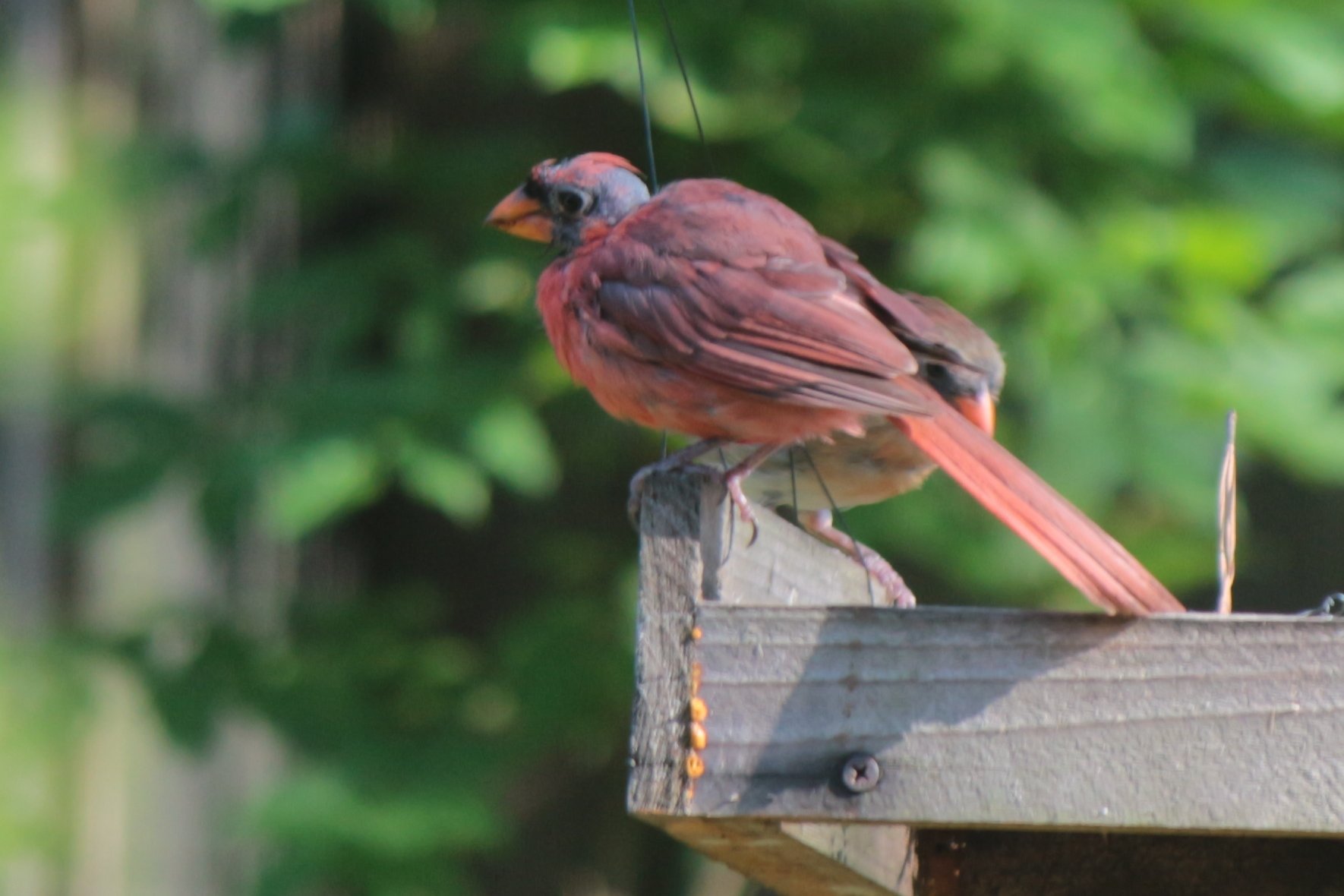Northern Cardinals-Beloved Redbirds
1/12/2023 By Sherry Thornburg
Species Overview
Diet: Omnivore – seeds, insects and berries
Average life span: 15 years
Size: 8 to 9 in (21 to 23 cm)
Weight: 1.5 to 1.8 oz (42 to 51 g)
Habitat: Edges of forests and thickets, low brushy areas, suburbs and parks
Cardinal Basics
The Cardinal is likely one of the first birds most people learn. They are widespread across the eastern half of the country and parts of Arizona. So popular, they are in high demand as a state bird. Seven states have claimed them. They are of the Cardinalidae famly, related to Grosbecks, Tangers, Buntings and the Desert Cardinal or Pyrrhuloxia.
The male is dressed to be noticed in the color of a Catholic Cardinal’s robe. The female is no drab bird either. She has red in her wings, tail, and crest. She can have yellow, orange and brown feather mixes depending on the season. Both have a black mask across their eyes and below their thick orange bills, though the female’s mask is not as dark. Both also have showy head crests.
Cardinal Food
Cardinals move in large groups to forage in the fall. You will see them mostly on the ground hunting seeds and in thick berry bushes such as yaupon holly, blackberry and mulberry.
Insect preferences include beetles, crickets, katydids, leafhoppers, cicadas, flies, centipedes, spiders, butterflies, and moths. This is a good bird to have around for pest control.
Attracting These Birds
Try Black Oil Sunflower seeds.
Try blackberries, mulberries, and grapes (with seeds) in the fall when their diet is mainly fruits.
Spring Nesting Season
When hormones are high during mating times, you will see male and female Cardinals at their territorial best, or worse, depending on your viewpoint. They are fierce. They will attack other Cardinals to secure their mate selection. They will attack other animals that get too close to their nests. You may have seen a Cardinal trap cats under cars, chase squirrels across yards and even attack their reflections in windows and the glossy finish of cars. This is all about securing mates and territory. They do calm down in time. Until then, if a Cardinal is attacking its reflection, dull the window or put a bag over the car mirror. They will lose interest once they can’t see their reflection.
Cardinal nests are built in shrubs and dense vine tangles 5 to 15 feet above ground. The female is the main builder. They may have 2 to 3 broods a year, with 2 to 5 whitish to greenish eggs speckled in brown per clutch. Incubation takes 7-13 days. While chicks are growing, the female sings to her mate, likely keeping him informed about approaching threats and food needs. The nests are only 4 inches wide with a 3-inch cup for the eggs to fit in. They are not reused.
Cardinals as Parents
If you have the good luck to gain a Cardinal family as tenants at your bird house, you will have a good view of how veracious baby birds can be. I have never seen a nest, but I have seen cardinals come back and forth to my feeder carrying off seeds with a quick turnaround. I have also seen them give my garden dirt a fine combing for grubs and other insects. I love birds that do that.
When the chicks fledge, parents will bring their babies to the yard, but may not let them on the feeder. I’ve seen these protective parents settle their little ones in tree branches, fences or rooftops to wait for mom or dad to fly back and forth for seeds. It could be a week or more before you see little ones on the feeder by themselves. Even then, some parents will feed them, beak to beak, rather than let them gather on their own.
The male Cardinal will lose his bright colors and take on a duller reddish brown while caring for babies in order to protect them. Another protection is removing baby waste. Cardinal chicks defecate after every feeding in sack form. Parents take the fecal sac to a distant area for dumping to hide their location from predators.
After the last babies have fledged, late summer and early fall, you may notice your cardinals getting drab-looking, and then bald. This is normal molt. I’ve heard that the females will hide during this time, but the poor males are more likely to be caught going bald. New all over feathers tend to look less than a Cardinal’s best, but that’s just their winter pattern. By spring, they will be back to bright and beautiful.
Final Word
Despite the fact Cardinals are not migratory birds they are listed as a protected species under the "Migratory Bird Treaty Act of 1918." It is illegal to own a Cardinal as a pet or to hunt them.
The Cardinal has been expanding out of their southeast range into the northeast and as far north as Canada. This is believed to be due to their affinity to backyard feeders. It’s not abnormal for birds to change their habits because of us. Cave Swallows are another bird that has changed its life pattern. In their case, it’s because we build such nice bridges and overpasses with dark undersides. Birds are adaptable. If you want to know more about our feathered friends, check out E-Bird.
Happy Birding
Photography
Title Image: Cardinal Portrait
Picture 1: Cardinal Spring Pair
Picture 2: Winter Female
Picture 3: Daddy Feeding Juvenile
Picture 4: Cardinal in Molt





